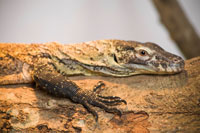Baby Varanus komodoensis hatched in August 2011 at the Los Angeles Zoo.
 The Komodo dragon is the largest species of lizard in the world. Photo credit: Riverbanks Zoo |
The Riverbanks Zoo and Garden in South Carolina has opened an exhibit featuring a pair of juvenile Komodo dragons (Varanus komodoensis), that hatched last year at the Los Angeles Zoo. The komodo dragons showcased at the zoo are the first in the zoo's history and are currently living in the Desert Gallery of the Aquarium-Reptile Complex. Once they grow large enough, they will be moved into a larger outdoor exhibit.
“We are excited to give our visitors an opportunity to watch as these young dragons grow into powerful predators,” Scott Pfaff, curator of herpetology at Riverbanks Zoo and Garden said in a prepared statement. “Komodos in captivity grow at a faster-pace, typically reaching adulthood in about 5 to 6 years, while dragons in the wild reach maturity in about 20 years.”
The Komodo dragon is native to the Indonesian archipelago, found on the islands of Komodo, Rinca, Flores, Gili Motang, and Padar. They are the largest lizard species in the world, growing up to 10 feet in length and weighing more than 150 pounds. They feed mostly on dead animals but are also well equipped to ambush and kill animals such as pig and deer.
The Komodo dragon is native to Komodo island and surrounding islands in Indonesia. Considered the largest species of lizard, the Komodo dragon can grow to nine feet in length and weigh up to 250 lbs. It eats meat and can take down pigs and deer, though it dines primarily on dead animals. It is said to have bacteria in its saliva, specifically E. coli, Staphylococcus sp., Providencia sp., Proteus morgani and P. mirabilis. In 2009, researchers with the University of Melbourne published evidence that the Komodo dragon also possessed a venomous bite. The Komodo dragon is also known to reproduce via parthenogenesis, in which growth and development of embryos occurs without fertilization from a male.
The Komodo dragon is an endangered species, with an estimated 4,000 to 5,000 left in the wild. Komodo dragons are listed in Appendix I of the Convention on International Trade in Endangered Species of Wild Fauna and Flora (CITES). According to CITES, species in Appendix I are threatened with extinction.



